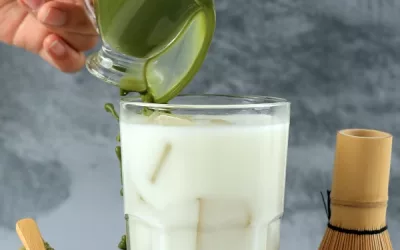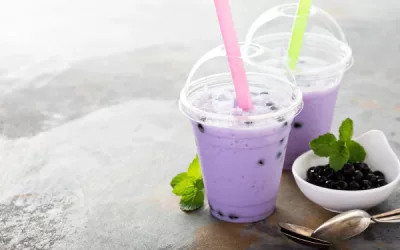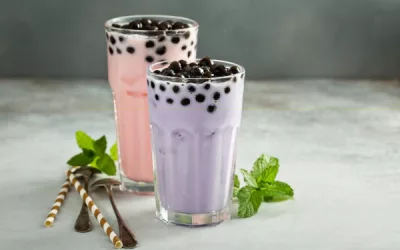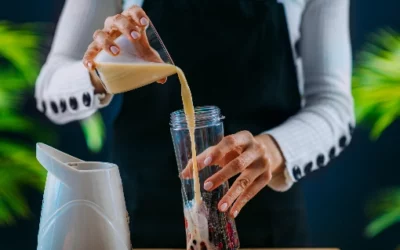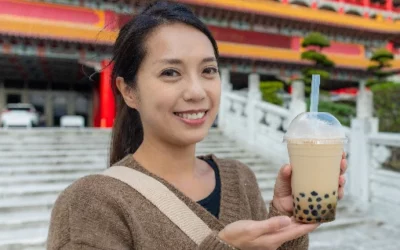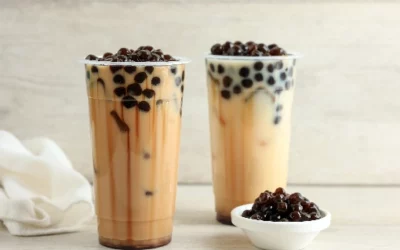When I first sipped bubble tea, I was instantly transported to a world of fun and flavour. The chewy tapioca pearls danced in my mouth, and the refreshing tea infused with fruity goodness made my taste buds sing. If you’re reading this, you likely share a curiosity about this delightful drink that has taken the world by storm. In this article, we will explore what bubble tea is, and also its fascinating history, diverse variations, and even the health implications involved. Whether you’re a food enthusiast, a cultural explorer, or simply someone intrigued by its sweet allure, you’ll find something to quench your thirst for knowledge. Let’s dive in and discover what makes bubble tea an exciting cultural phenomenon!
Table of Content
- What is bubble tea?
- What are the origins of bubble tea?
- How has bubble tea become a global phenomenon?
- What are the different types of bubble tea?
- What are the differences between black tea and green tea bubble tea?
- How does oolong tea bubble tea differ from other types?
- What are the popular fruit tea flavours in bubble tea?
- What are the health concerns associated with bubble tea?
- Sugar content
- Calorie count
- Potential allergens
- Dental health
- Are there any healthier alternatives to traditional bubble tea?
- How can you make bubble tea at home?
- What ingredients are needed to make bubble tea at home?
- What are the steps to prepare homemade bubble tea?
- How can you customise homemade bubble tea to your taste?
- What are some of the most popular bubble tea chains globally?
- What is the cultural significance of bubble tea?
- Conclusion
What is bubble tea?
Bubble tea, also called boba tea or pearl milk tea, is a delightful beverage originating from Taiwan in the 1980s. This popular drink combines tea with milk, fruit, or other flavourings, and it includes chewy tapioca pearls or fruit jellies that add a unique texture and fun element to the drinking experience. Bubble tea’s versatility allows for countless variations, from classic milk teas to fruity blends and innovative toppings, making it a global favourite.
The drink has a few essential components: tea (usually black or green), a sweetener, a creamy element like milk, and what’s commonly referred to as the “bubbles”—though these bubbles are actually chewy tapioca pearls.
The preparation typically involves brewing the tea, mixing it with milk and sweetener, and then shaking or blending it with ice to create a frothy texture. Finally, the mixture is poured over the tapioca pearls and enjoyed through an oversized straw.
What are the main ingredients of bubble tea?
Bubble tea is built on a simple but delicious foundation. The main ingredients include:
- Tea: Usually black or green, but other varieties like oolong can also be used.
- Milk: Dairy or non-dairy options like almond, soy, or oat milk.
- Sweetener: Simple syrup, honey, fruit syrups, or condensed milk.
- Tapioca pearls: Made from tapioca starch, these are cooked until chewy.
- Ice: To make the drink frosty and refreshing.
Each of these ingredients plays a crucial role in crafting a satisfying bubble tea experience. The tea provides the flavour backbone, the milk adds creaminess, the sweetener balances the flavours, and the tapioca pearls introduce a fun, chewy texture that makes drinking bubble tea a unique pleasure.
How is bubble tea prepared?
Preparing bubble tea is straightforward but requires a bit of attention to detail. Here’s a simple step-by-step guide:
- Brew your choice of tea and let it cool.
- Prepare the tapioca pearls by cooking them in boiling water until they reach a chewy consistency.
- Mix the brewed tea with milk and your preferred sweetener.
- Shake or blend this mixture with ice until it becomes frothy.
- Pour the mixture over the cooked tapioca pearls in a glass.
This process results in a cold, refreshing drink with different layers of flavours and textures.
What are the common variations and toppings?
Bubble tea’s charm lies in its almost endless customisation options. Here are some popular variations and toppings:
- Variations:
- Fruit teas: Made with a base of black or green tea and mixed with fruit juices or purées.
- Milk teas: Classic black or green tea with added milk or cream.
- Blended teas: Smoothie-like versions with blended tea and ice, sometimes including fruit.
- Toppings:
- Popping boba: Juice-filled pearls that burst in your mouth.
- Fruit jellies: Flavoured jellies made from agar or coconut.
- Pudding: Custard-like additions that add extra creaminess.
- Aloe vera: Chunks of aloe for a refreshing crunch.
These variations and toppings allow you to experiment and find your favourite combination, making each bubble tea experience unique.
What are the origins of bubble tea?
Bubble tea, often referred to as boba tea, has its origins in Taiwan during the 1980s. This unique drink combines tea with milk, sugar, and chewy tapioca pearls, creating a delightful texture and taste experience.
While there are many variations of bubble tea today, its fundamental charm remains rooted in those original elements. Below is a detailed timeline highlighting the key events in the invention and spread of bubble tea, along with its cultural impact.
To understand the table, look at the “Year” column for the relevant date, the “Event” column for the milestone, the “Description” column for detailed context, and the “Cultural Impact” column to see how this event influenced culture and society.
| Year | Event | Description | Cultural Impact |
|---|---|---|---|
| 1980s | Invention in Taiwan | Bubble tea was first created by mixing Taiwanese tea with condensed milk and adding tapioca pearls. | Became a staple in Taiwanese culture and a symbol of innovation. |
| 1990s | Popularity in East Asia | Bubble tea spread rapidly to neighbouring Asian countries like Japan, South Korea, and China. | Cemented its place as a trendy beverage and a part of modern café culture. |
| 2000s | Introduction to Western Market | First bubble tea shops opened in the United States and Canada, gaining popularity among young urban populations. | Inspired fusion beverages and grew into a cultural bridge between East and West. |
| 2010 | Social Media Boom | Platforms like Instagram and Facebook helped bubble tea gain global visibility through aesthetically pleasing posts and user content. | Turned bubble tea into a global phenomenon, beloved by influencers and foodies. |
| 2015 | Health-conscious Variations | Introduction of healthier options such as using green tea, alternative sweeteners, and organic ingredients. | Allowed bubble tea to cater to a wider audience, including health enthusiasts. |
| 2020 | Pandemic Popularity | Surge in DIY bubble tea kits during COVID-19 lockdowns, with many people making the drink at home. | Reinforced bubble tea as a comforting, versatile beverage amidst global crises. |
| 2023 | Global Franchise Expansion | Major bubble tea brands expanded globally with franchises, making the drink accessible in most major cities around the world. | Solidified bubble tea’s status as a mainstream global culinary delight. |
Why is bubble tea called bubble tea?
Bubble tea gets its name from its bubbly appearance when shaken, not from the tapioca pearls themselves, as is commonly believed. The term “bubble” comes from the froth formed when the tea is shaken with ice, milk, and sugar. This frothy layer caps the drink, giving it a signature look that sets it apart from other beverages.
Let’s break this down further:
- The “bubbles” in the original bubble tea were simply the frothy bubbles on top, created by vigorously shaking the mixture.
- Tapioca pearls, introduced later, were initially called “boba,” a colloquial term for large pearls, hence leading some to associate the bubbles with the pearls.
- Flavour and texture enhance the experience, creating a combination of creamy, sweet, and chewy elements.
Understanding this can add a new layer of appreciation the next time you order this delightful drink.
What are the different types of bubble tea?
Bubble tea comes in a delightful array of types and flavours, allowing each person to find their perfect combination. From fruit-infused teas to milk-based varieties, and an assortment of toppings, there’s something for everyone. Here are some of the most popular types of bubble tea:
- Classic Milk Tea: Traditional black tea with milk and sugar, plus tapioca pearls.
- Fruit Tea: Tea blended with fruit juices or purees such as mango, peach, lychee, or passionfruit.
- Matcha Tea: Green tea powder mixed with milk and sweetener, offering a vibrant green colour and unique taste.
- Taro Tea: Purple in hue, made from taro root, with a creamy and slightly nutty flavour.
- Honeydew Tea: Blended with honeydew melon juice or flavouring, providing a sweet and fresh taste.
Another interesting aspect of bubble tea is the variety of toppings that can be added:
- Tapioca Pearls (Boba): Chewy black or white pearls made from tapioca starch.
- Popping Boba: Fruit juice-filled pearls that burst in the mouth.
- Aloe Vera: Refreshing and slightly crunchy, often used in healthier variations.
- Grass Jelly: Dark jelly with a herbal flavour, adding a unique texture.
- Egg Pudding: Soft and custardy, lending a dessert-like quality to the drink.
The vast variety of bubble tea ensures you can experiment and discover your favourite combination.
In the early 1990s in Taiwan, bubble tea became immensely popular among school-going children and teenagers, leading to increased competition among street vendors. Vendors began to innovate with different flavours and ingredients to stand out. This trend gave rise to the diversified bubble tea marketplace we see today.
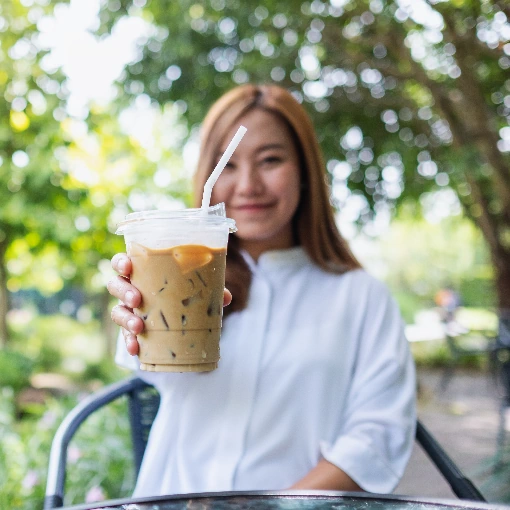
How has bubble tea become a global phenomenon?
Ah, bubble tea, the drink that looks like a science experiment gone wrong but tastes like a masterpiece. Now, how did this quirky drink slurp its way around the globe? I mean, you wouldn’t expect something featuring chewy balls at the bottom to become the next big thing, right? Yet, here we are.
Bubble tea started in Taiwan in the ’80s. Taro or milk tea mixed with these little tapioca pearls, also lovingly known as “boba.” It was the brainchild of some brilliant person who probably thought, “What if I put pudding elements in a drink?” Whatever the mad genius drank that day paid off.
Now, let’s talk about why this drink is now available in a hip café near you. First off, international popularity. The drink spread through Asia, hitting countries like Hong Kong, Japan, and South Korea. Eventually, it swam across the Pacific and landed in trendy cities in the US, then Europe, and even as fast food joints in the Middle East. Every place it landed, people lapped it up.
Which countries have embraced bubble tea the most?
You might be ready to hop on a plane to check out bubble tea hotspots. While Taiwan is the birthplace, it’s not the only place where bubble tea has taken the world by storm.
- United States: Cities like San Francisco and New York City have bubble tea joints on almost every corner. If you’re in LA, the sheer number of boba spots might make you think it’s the new Silicon Valley.
- Japan: You’d think they got enough with matcha everything, but no. They went all out with their own twist on bubble tea.
- South Korea: Not to be outdone, Seoul’s fashion streets are practically lined with bubble tea cafes.
- Canada: Toronto and Vancouver have turned boba into a cultural staple. It’s almost a rite of passage there now.
- Australia: Sydney and Melbourne have caught onto the bubble tea craze with an enthusiasm that matches their love for avocados.
Pretty much, if there’s a hipster scene, there’s bubble tea.
Social media is like the fairy godmother of bubble tea. Platforms like Instagram and TikTok have propelled this drink to dizzying heights. Imagine posting about your boring old coffee on Instagram—yawn. Now picture holding a colourful, layered bubble tea—double tap!
- Instagrammable: Bubble tea looks like art in a cup. Naturally, people love to share pictures of it online.
- TikTok Trends: Challenges and reviews about bubble tea flavours keep the buzz alive.
- User-generated content: Everyone’s an influencer when it comes to food. Peer recommendations rule.
- Celebrity Endorsements: If a celeb is seen sipping on something trendy, everyone wants in.
- Hashtags Galore: #BubbleTea #BobaLover #BubbleTeaAddict; hashtags connect the global bubble tea community.
With every sip, snap, and hashtag, bubble tea gets a little more famous.
What are some common regional adaptations of bubble tea?
You thought bubble tea was just tea and boba pearls? Oh boy, you’re in for a treat. The drink has been adapted in various ways to please local palates, and the creativity is next level.
- US: Think along the lines of ice cream-flavoured boba teas, like cookies and cream or salted caramel.
- Japan: Matcha bubble tea and soy milk variations abound.
- Philippines: Halo-halo inspired bubble teas, which add fruits and gelatin.
- Thailand: Thai milk tea versions with those beautiful orange hues.
- Europe: You might find healthier versions incorporating fresh fruits and organic ingredients.
It’s like bubble tea is a chameleon changing its flavours to fit the scenery.
Considering bubble tea’s rise from a street-side stall in Taiwan to a global sensation, its journey is nothing short of remarkable. Much like how sushi became a worldwide hit after starting as a street snack in Edo-era Japan, bubble tea’s transformation from a niche treat to an international obsession is truly fascinating.
Whether you love it or can’t stand it, its influence is undeniable, making it the beverage of our interconnected world. So next time you see a bubble tea shop, remember it’s not just a drink; it’s a delicious piece of global history in a cup. Cheers!
What are the different types of bubble tea?
So, you want to dive into the bubbly world of bubble tea, eh? Brace yourself because it’s more than just sipping those tapioca pearls through an oversized straw. Let’s break it down, starting with the traditional big hitters, and then we’ll talk about how misleadingly innocent it can be with fruit flavours and just how pretentious it can get with some varieties.
First up, you’ve got your classic black tea. Ever had English Breakfast or Earl Grey? Yep, same stuff but amped up with chewy pearls. Black tea serves as a robust base, offering that strong kick you need to wake up. Then, you’ve got green tea—it’s like the spa day option; delicate, smooth, and won’t have you pinging off the walls.
And don’t even get me started on oolong. Think of it as the hipster cousin. It’s meticulously semi-fermented and lands somewhere between black and green tea on the taste spectrum. Add in a splash of fruit syrups or milk, and you’re good to go. Now, for milk teas, you pair your tea base with milk, non-dairy creamer, or even condensed milk, giving you that creamy, satisfying texture.
Lastly, fruit teas come in all sorts of flamboyant flavours. Mango, lychee, passion fruit – you name it. Perfect for when you’re roped in by peer pressure on a hot day.
What are the differences between black tea and green tea bubble tea?
Black tea and green tea in bubble tea aren’t just about taking your brews differently; they offer distinct taste profiles, caffeine content, and health benefits.
- Taste: Black tea gives you a bold, malty flavour, while green tea is more about those soft, grassy notes.
- Caffeine: Black tea generally packs more caffeine compared to the milder green tea, so opt for the latter if you’re not looking to stay up binge-watching Netflix.
- Colour: Let’s not overlook the obvious; black tea introduces a darker, almost caramel shade to your drink. Green tea is light and almost… well, green.
- Health Benefits: Black tea’s rich in antioxidants, but green tea is often touted for its higher concentration of L-theanine, which helps balance caffeine’s jittery effects.
Pick your poison wisely; these differences are what make each one special.
- Black tea: bold, malty, higher caffeine
- Green tea: soft, grassy, lower caffeine
- Black tea: rich, dark colour
- Green tea: light, almost green hue
- Black tea: good for antioxidants
- Green tea: known for balancing caffeine effects
If you’re looking to power through an all-nighter or just want a refreshing sip, the choice between black and green tea boils down to your flavour and functional preferences.
How does oolong tea bubble tea differ from other types?
Oolong tea bubble tea stands out because of its unique semi-fermented nature. It’s the middle child of the tea family, combining the best traits of black and green teas without leaning too heavily towards either.
- Fermentation: Oolong tea is partially fermented, unlike black tea (fully fermented) or green tea (non-fermented).
- Taste: It delivers a nuanced flavour profile—somewhere between the robustness of black tea and the fresh, light taste of green tea.
- Caffeine: Moderate caffeine content, making it a good option for those who want to avoid the jitters.
- Processing: Often hand-rolled and processed meticulously, contributing to its slightly higher price.
- Aroma: Ranges from floral to fruity, making it a delightful sensory experience.
So, if you’re looking for something that’s not too bold but not too mild, and provides an aromatic experience beyond the ordinary, oolong’s your go-to.
- Partially fermented
- Balanced flavour profile
- Moderate caffeine content
- Meticulous processing
- Floral to fruity aroma
It’s a crowd-pleaser for sure, and perfect if you want to feel a tad more sophisticated about your bubble tea experience without crossing into snob territory.
What are the popular fruit tea flavours in bubble tea?
Fruit tea flavours in bubble tea are like the rebellious teenagers of the bubble tea world. They break all the traditional rules but still manage to be oh-so-loved.
- Mango: The tropical classic. Sweet, tangy, and just screams summer.
- Lychee: Light, fragrant, and perfect for those who like their teas subtly sweet.
- Passion Fruit: Bold and tart, for when you want a taste explosion.
- Honeydew: Sweet and refreshing, it’s like biting into a fresh melon.
- Strawberry: Universal appeal with its familiar and comforting taste.
These flavours are perfect for bubble tea newbies who might find the taste of tea a bit too “grown-up” for their liking.
- Mango – tangy and quintessentially tropical
- Lychee – fragrant and subtle
- Passion Fruit – bold and tart
- Honeydew – sweet and refreshing
- Strawberry – comforting and familiar
With such a vibrant array of choices, these fruit teas pull in those who are more inclined towards a refreshing, fruity escape than a traditional tea experience.
In the late ’80s, when bubble tea was starting to gain traction in Taiwan, it wasn’t the plethora of flavours we see today. One enterprising tea house owner decided to add fruit syrups to traditional bubble tea, hoping to attract younger customers. This one gamble changed everything, and suddenly, fruit-flavoured bubble tea options popped up everywhere, leading to the rainbow-coloured menus we now love. Funny how a dash of innovation—and maybe a bit of desperation—can birth a cultural phenomenon, isn’t it?
What are the health concerns associated with bubble tea?
Ah, bubble tea. That fancy drink with those chewy pearls bouncing around at the bottom. It’s tasty, it’s trendy, but is it healthy? That’s the million-dollar question. Spoiler alert: it’s not all rainbows and unicorns when it comes to your health. We’re talking sugar overload, calorie catastrophe, and don’t even get me started on dental issues. But let’s break it down, shall we?
Alright, let’s get into the nitty-gritty of why you might want to think twice before downing that second (or fifth) bubble tea of the day.
Sugar content
Let’s kick things off with sugar, the not-so-sweet truth. Bubble tea is laden with the stuff. You might think you’re just having a refreshing drink, but you’re actually indulging in a sugar bomb.
- A typical serving of bubble tea can contain anywhere from 30 to 50 grams of sugar. That’s equivalent to around 7 to 12 teaspoons!
- The pearls themselves are often soaked in sugary syrup, adding even more to the mix.
- Flavoured syrups, fruit juices, and condensed milk – all common additives – ramp up the sugar content even further.
- Perhaps you prefer it ‘less sweet’—that still means a hefty sugar load, often around 50% of the usual amount.
- Your daily recommended sugar intake? Ideally, it’s about 25 grams for women and 37.5 grams for men. One bubble tea and you’re already over the limit.
You didn’t expect that, did you? The sugar in bubble tea isn’t just empty calories. It contributes to weight gain, increases the risk of diabetes, and let’s face it, does nothing for your teeth.
Calorie count
You might want to sit down for this. Bubble tea is not what you’d classify as a low-calorie beverage. In fact, it’s more like having a liquid dessert.
- Depending on the ingredients, one serving can have anywhere from 300 to 500 calories.
- Those pearls—made from tapioca—are pure carbohydrates and contribute a significant chunk of those calories.
- Add-ons like flavoured milk, creamers, and syrups only pile on more calories.
- Even plain green or black tea-based versions aren’t entirely innocent. The moment you add sweeteners, the calorie meter shoots up.
- Just for comparison, a regular soda has roughly 140-150 calories per can. So, bubble tea is like having two or three sodas in one go.
The bottom line? Bubble tea is as calorically dense as many fast-food items. If you’re counting calories, you might want to count these out.
Potential allergens
If you have food allergies, bubble tea could be a minefield. You wouldn’t want your fun snack to turn into a foodie nightmare.
- The tapioca pearls themselves are generally gluten-free but could be cross-contaminated during preparation.
- Some versions use dairy or non-dairy creamers, which could cause issues for those with lactose intolerance or allergies to nuts or soy (depending on the creamer used).
- Flavoured syrups and powders often contain a host of additives and preservatives, which might set off some allergic reactions.
- Popping boba – those fun, liquid-filled orbs – can contain artificial colourings and flavourings, which aren’t always allergen-friendly.
- Cross-contact is a concern as many bubble tea shops prepare drinks in shared spaces with other allergen-containing ingredients.
Health concerns not enough to scare you off yet? Don’t worry, we’re getting to the heavier stuff.
Dental health
Bubble tea, sugary heaven for taste buds but a nightmare for teeth. Those pearls are chewy, sticky, and love clinging to your teeth.
- High sugar content is a prime breeding ground for bacteria, leading to cavities and tooth decay.
- The syrupy consistency means it sticks to your enamel, causing prolonged exposure to sugar.
- Teeth staining is another issue. Those brightly coloured teas and syrups are not your enamel’s best friends.
- Acidic ingredients, such as certain fruit purees or juices, can also wear down your enamel.
- Frequent consumption can lead to chronic dental problems—think multiple trips to the dentist and lots of drilling. Not fun.
So, if you want to keep your pearly whites, perhaps cut back on the pearls in your tea.
Now, let’s get to the alternatives, because everyone loves a good comeback story.
Are there any healthier alternatives to traditional bubble tea?
Don’t give up on bubble tea just yet. There are ways to have your pearls and drink them too, without loading up on sugar and calories. Behold, the healthier options.
- Opt for “less sugar” or “no sugar” versions – Sometimes less is more.
- Swap out regular tapioca pearls for healthier alternatives like aloe vera, chia seeds, or agar bubbles.
- Choose fresh milk instead of creamers or non-dairy creamers that are often loaded with additives.
- Unsweetened green tea or black tea as the base is a great way to cut down on unnecessary calories and sugar.
- Drink smaller portions—yes, even a kid’s size could hit the spot without the guilt.
With these tweaks, you can enjoy your favourite drink without causing a nutritional crisis.
And here’s a historical tidbit for you: Bubble tea originated in Taiwan during the 1980s, becoming a global phenomenon by the 2000s. Legend has it that the drink was created by accident when teahouse owners started adding tapioca pearls to their teas as a marketing gimmick. Fast forward to today, bubble tea has conquered the world, but the health concerns remain. So, drink up, but maybe think about what exactly you’re slurping down!
How can you make bubble tea at home?
So, you want to whip up some bubble tea at home? Excellent choice – it’s like combining the magic of a science experiment with the joy of dessert. Let’s dive into the world of DIY bubble tea and make your kitchen the best tea shop in town.
First, you need to gather your troops – the ingredients. Being prepared is half the battle, and in this case, it ensures you get a delicious drink. Next come the steps, and I promise they won’t leave you tied up in a tangle. Sprinkle in some tips to elevate your concoction from decent to divine. And finally, we’ll cover some pitfalls to avoid and creative flavours to try. Sound good?
What ingredients are needed to make bubble tea at home?
Before you roll up your sleeves, you’ll need to assemble your shopping list. Here’s what you’ll need:
- Tea: Black, green, or oolong – pick your poison.
- Tapioca pearls: These are the ‘bubbles’ that give bubble tea its name.
- Sugar: To sweeten the deal, quite literally.
- Water: For brewing your tea and cooking those pearls.
- Milk or milk alternative: Anything from cow’s milk to almond milk works.
- Flavouring: Variety is the spice of life, so think about fruit syrups, honey, or even condensed milk.
These items are your passport to bubble tea bliss. Each component contributes to the overall experience, so don’t skimp or substitute wildly unless you’re up for an adventure.
What are the steps to prepare homemade bubble tea?
Alright, with ingredients in tow, it’s time to get cooking. Here’s your straightforward, foolproof plan:
- Brew your tea: Steep your chosen tea in boiling water. Stronger is better since it needs to stand out among the other flavours.
- Cook the tapioca pearls: Boil water and add the pearls. Stir to keep them from sticking together, then let them simmer for about 15-20 minutes. Remember, nobody likes crunchy pearls in their drink unless it’s an avant-garde art project.
- Prepare your sweetener: Mix sugar with hot water to make a simple syrup. Adjust the ratio to match your sweet tooth.
- Assemble the drink: Combine the tea, milk, and syrup in a shaker (or any container with a lid). Give it a good shake to blend.
- Serve and enjoy: Add the cooked tapioca pearls to your glass, followed by the tea mixture. Use a wide straw to sip those delightful bubbles.
Sounds simple, right? Let’s stay on that train with some tips to make your tea stand out.
- Perfect brewing: Over-steeping can make tea bitter, so watch the clock.
- Pearl freshness: Only cook what you’ll use right away. They lose their texture after a few hours.
- Shaker move: Shake, don’t stir. It mixes everything better.
- Serve chilled: Nobody enjoys lukewarm bubble tea.
How can you customise homemade bubble tea to your taste?
Here comes the fun part: customisation. Think of bubble tea as a blank canvas and you’re the artist wielding a giant bubble-shaped brush.
- Flavour syrups: Add a splash of fruit-flavoured syrup – mango, lychee, or strawberry.
- Alternative sweeteners: Swap sugar with honey, agave nectar, or even maple syrup.
- Different pearls: Try bursting fruit pearls for a juicy surprise.
- Ice or no ice: Adjust the chill level of your drink to suit your mood.
- Jelly toppings: Add coconut jelly, grass jelly, or aloe vera cubes for extra texture.
Customisation lets you become a bubble tea mixologist in your own kitchen. You can experiment until you find your perfect balance of flavours and textures. Soon enough, your friends will be knocking down your door for a taste.
Let’s finish with a tidbit from the annals of bubble tea history. Did you know that bubble tea dates back to the 1980s in Taiwan? One legend attributes its creation to Lin Hsiu Hui, a teahouse manager who, during a boring meeting, dumped her tapioca dessert into her tea. The concoction was an instant hit, prompting the teahouse to add it to their menu. Fast forward to today, the humble drink has become a global sensation, offering endless variations to those willing to put their own spin on it.
So, why not join the ranks of creative bubble tea pioneers?
What are some of the most popular bubble tea chains globally?
Ready to dive into the world of boba behemoths? These brands are like the Avengers of bubble tea. Each one brings its unique flair to the table (or should I say, cup?).
- Chatime: This Taiwanese gem is a global superstar with a presence in over 30 countries. Known for its consistency and quality, Chatime offers a wide range of flavours that cater to every palate. From fruity teas to creamy milk teas, they’ve got it all.
- Gong Cha: With a name that translates to “tribute tea for the emperor,” Gong Cha sets the bar high. Originating in Taiwan, they’ve expanded internationally and are celebrated for their customizable options and fresh ingredients.
- Koi Thé: This chain, born out of Taiwan but spreading its wings in Singapore, is famous for its golden bubble teas. They’re all about quality control, ensuring that every cup is brewed to perfection.
- Tiger Sugar: If you’re on Instagram, you’ve probably seen a Tiger Sugar cup. Known for its signature brown sugar boba milk, this chain has taken the world by storm with its aesthetically pleasing and delicious drinks.
- Coco Fresh Tea & Juice: This one has a massive international footprint. Coco has a diverse menu that goes beyond just tea, including fresh juices and slushies, making it a versatile choice for any craving.
These chains have perfected the concoction of tea, milk, and pearls. Now, step into the virtual realm to amplify your bubble tea experience.
How can online reviews help in finding authentic bubble tea shops?
Ah, online reviews – the modern-day oracle. If used wisely, they can lead you straight to bubble tea nirvana. But it can be a minefield out there, so let’s navigate it with precision.
- Check multiple platforms: Don’t just stop at one site. Cross-reference reviews on Google, Yelp, and social media for a comprehensive view.
- Look for specific details: Authenticity lies in the details. Seek reviews that mention the texture of the pearls, the balance of sweetness, and the freshness of the tea.
- Filter for recent reviews: Bubble tea shops can change hands or quality over time. Recent reviews reflect the current state of affairs.
- Pay attention to photos: A picture is worth a thousand words, especially when it comes to food. Look for posts with clear images of the drinks; this can give you an idea of presentation and ingredient quality.
- Listen to the locals: If you’re in a city with a strong bubble tea culture, see what the locals are saying. They often have the best intel on where to find the most authentic experience.
Remember, stars alone don’t cut it. Delve deep into the narrative behind those stars to uncover the hidden gems.
What should you look for in a good bubble tea shop?
Alright, you’re geared up with chains and online reviews, but how do you spot a top-tier bubble tea joint yourself? It’s like knowing how to pick ripe fruits – some tips can make all the difference.
- Fresh ingredients: The tea should taste like tea, not sugar water. Real fruit, fresh milk, and high-quality tea leaves are non-negotiable.
- Perfect pearls: The tapioca pearls should be chewy but not too hard or mushy. It’s a fine line, and a good shop gets it right every time.
- Customizability: You should be able to adjust sweetness and ice levels to your preference. No one-size-fits-all when it comes to bubble tea.
- Cleanliness and ambiance: A clean shop with a pleasant ambiance goes a long way. If they care about the shop’s appearance, they probably care about the quality of their drinks too.
- Friendly and knowledgeable staff: Staff should know their menu inside out and be willing to make recommendations. A smile goes a long way.
Trust your instincts – and your taste buds. If it looks good, tastes good, and the vibe feels right, you’ve struck boba gold.
Speaking of boba gold, did you know that bubble tea has a rich history rooted in Taiwanese culture? Back in the 1980s, a tea shop owner named Lin Hsiu Hui concocted this now-world-famous drink almost by accident. During a meeting, she playfully poured her dessert, fen yuan (a sweet tapioca pudding), into her tea. The combination was a hit, sparking the birth of bubble tea. This delightful mishap at the Chun Shui Tang teahouse in Taichung set off a global craze. So, the next time you sip on that delicious drink, remember it’s a little piece of history in a cup!
What is the cultural significance of bubble tea?
Bubble tea, also affectionately known as boba tea, is more than just a drink. This quirky concoction has transcended from a simple beverage to a symbol of cultural richness and global influence. Originating from Taiwan in the 1980s, bubble tea has wormed its way into the hearts of many, becoming a significant element in Taiwanese culture and beyond.
You might wonder how a drink with chewy tapioca balls, endless flavours, and Instagram-worthy aesthetics could carry so much weight. Well, strap in because we’re diving into its cultural whirlpool.
How does bubble tea play a role in Taiwanese culture?
Bubble tea is to Taiwanese culture what tea is to the British: absolutely central. This colourful drink is not just a refreshing treat but a cultural icon interwoven with the daily lives of Taiwanese people.
- Origin Story: Bubble tea emerged in Taiwan in the 1980s, blending tea, milk, and those iconic tapioca pearls.
- Traditional Meets Modern: It showcases Taiwan’s knack for combining traditional tea with modern flair.
- Local Pride: Highly regarded by locals, bubble tea brands like Chun Shui Tang and Gong Cha are feather’s in the nation’s cap.
- Economic Boom: Bubble tea shops dot the cities, contributing significantly to local businesses.
- Culinary Influence: Taiwanese night markets revel in bubble tea, accompanying everything from stinky tofu to oyster omelettes.
In Taiwan, waving a cup of bubble tea isn’t just about quenching thirst; it’s embracing a slice of the island’s soul.
Why are bubble tea shops considered cultural hubs?
You know those cosy pubs in the UK where everyone gathers to chat and unwind? Bubble tea shops are the Taiwanese equivalent, but with fewer pints and more pearls. These places are modern-day social sanctuaries.
- Social Scenes: People meet for a bubble tea date, catch up with mates, or even seal business deals over a cup.
- Free Wi-Fi Zones: They offer free Wi-Fi, essential for students and digital nomads alike.
- Community Spaces: These shops host events, from live music nights to art exhibitions.
- Unique Decor: With themes ranging from high-tech sci-fi to rustic chic, each shop offers a unique experience.
- Comfort Food: Beyond drinks, many also serve snacks, turning a quick bubble tea run into a mini culinary adventure.
Bubble tea shops are where business mixes with pleasure, and where conversations flow as freely as the tapioca pearls in your drink.
How has bubble tea influenced youth culture globally?
It’s pretty clear that the youth worldwide have embraced bubble tea with open arms (and open wallets). This drink has evolved from a local favourite to a global trendsetter, influencing youth culture in myriad ways.
- Trend Machine: From TikTok challenges to Instagram posts, bubble tea is a staple of social media.
- Fashion Statements: Merch featuring bubble tea designs—from t-shirts to phone cases—are all the rage.
- DIY Craze: Youngsters try their hand at DIY bubble tea kits, becoming mini baristas in their kitchens.
- Cultural Exchange: Thanks to this drink, youth are getting curious about Taiwanese culture, learning more about its traditions and cuisine.
- Franchise Favorites: Chains like Gong Cha and Koi Thé have spread worldwide, becoming cool hangout spots for teens and young adults.
When it comes to bubble tea, the youth have taken it and run with it, transforming a simple drink into a lifestyle statement.
Back in the 1980s, when bubble tea was bubbling up in Taiwan, another cultural revolution was happening. Michael Jackson’s ‘Thriller’ hit the music charts, changing the landscape of pop culture globally. Just like MJ’s legendary moves influenced generations of dancers and music lovers, bubble tea has sashayed its way into the hearts and hands of people around the world. Both have shown that whether through captivating dance moves or a delightful sip, cultural revolutions can come from the most unexpected places.
Conclusion
As we’ve explored the multifaceted world of bubble tea, it’s clear that this beloved beverage is much more than just a trendy drink; it embodies a rich history, diverse variations, and significant cultural implications that resonate worldwide. From its humble beginnings in Taiwan to its status as a global sensation, bubble tea captures hearts and taste buds across continents, bridging cultures through its delightful concoctions and unique textures.
The importance of understanding bubble tea goes beyond its ingredients and preparation methods. It serves as a testament to cultural exchange, showcasing how food can unite us, evoke shared experiences, and even influence youth culture. As we delve into its sweet and chewy nature, we must also remain mindful of its health implications, encouraging moderation while exploring healthier alternatives that can satisfy our cravings without compromising well-being.
For those inspired to make bubble tea at home, the journey does not end here. Consider experimenting with various ingredients and flavours, allowing personal taste to guide you, and perhaps even creating your own variations that reflect your culinary spirit. Venturing into local shops, or researching online reviews can lead to discovering authentic experiences that are steeped in tradition.
Reflecting on this journey, I am reminded of the saying, “Food is the universal language.” In the context of bubble tea, this rings particularly true. As you sip your next cup, think about the stories, cultures, and connections it represents. In what ways can you celebrate this delightful beverage as part of your own experience? The world of bubble tea is vast and inviting—let it inspire your exploration of culture, taste, and community.
Resources
- Bubble Tea Consumption and Its Association with Obesity among Young Adults
- Decarbonizing the food and beverages industry: A critical and systematic review of developments, sociotechnical systems and policy options
- Global food supply chain resilience assessment: A case in the
- A preliminary investigation of nutritional intake and supplement use in Australian ME/CFS patients
- The effects of the intake of plant foods on the human metabolome
- Unhealthy Food and Beverage Consumption during Childhood and Risk of Cardiometabolic Disease: A Systematic Review of Prospective Cohort Studies


